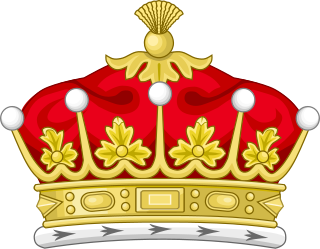
Earl of Winchilsea is a title in the Peerage of England held by the Finch-Hatton family. It has been united with the title of Earl of Nottingham under a single holder since 1729. The Finch family is believed to be descended from Henry FitzHerbert, Lord Chamberlain to Henry I. The name change to Finch came in the 1350s after marriage to an heiress by a member of the Finch family. In 1660 the 3rd Earl of Winchilsea was created Baron FitzHerbert of Eastwell, Kent, in recompense for his efficient aid in the Restoration of the Monarchy. The Herbert family of Wales, Earls of Pembroke, share common ancestry but bear differenced arms. A later member of the family, Sir William Finch, was knighted in 1513. His son Sir Thomas Finch, was also knighted for his share in suppressing Sir Thomas Wyatt's insurrection against Queen Mary I, and was the son-in-law of Sir Thomas Moyle, some of whose lands Finch's wife inherited. Thomas's eldest son Moyle Finch represented Weymouth, Kent and Winchelsea in the House of Commons. In 1611 he was created a baronet, of Eastwell in the County of Kent.

Christopher Hatton, 1st Viscount Hatton (1632–1706) was an English aristocrat and diplomat.

Daniel Finch, 2nd Earl of Nottingham, 7th Earl of Winchilsea PC, was an English Tory statesman during the late seventeenth and early eighteenth centuries.

Earl of Aylesford, in the County of Kent, is a title in the Peerage of Great Britain. It was created in 1714 for the lawyer and politician Heneage Finch, 1st Baron Guernsey. He had already been created Baron Guernsey in the Peerage of England in 1703. Finch was the younger son of Heneage Finch, 1st Earl of Nottingham and the great-grandson of Elizabeth Heneage, 1st Countess of Winchilsea. Lord Aylesford's eldest son, the second Earl, represented Maidstone and Surrey in Parliament. In 1712, he married Mary Fisher, daughter of Sir Clement Fisher, 3rd Baronet. Through this marriage Packington Hall in Warwickshire came into the Finch family. Their son, the third Earl, sat as a Member of Parliament for Leicestershire and Maidstone. His eldest son, the fourth Earl, represented Castle Rising and Maidstone in the House of Commons, and after entering the House of Lords on his father's death, served as Captain of the Yeomen of the Guard from 1783 to 1804 and as Lord Steward of the Household from 1804 to 1812.
Sir Heneage Finch, 3rd Earl of Winchilsea (1628–1689) of Eastwell, Kent, was the 3rd Earl of Winchilsea.

Daniel Finch, 8th Earl of Winchilsea and 3rd Earl of Nottingham, was a British politician.
Guy Montagu George Finch-Hatton, 14th Earl of Winchilsea and 9th Earl of Nottingham. Finch-Hatton was brother to renowned big-game hunter Denys Finch Hatton and his daughter married Whitney Straight, of the American Whitney family.

Elizabeth Finch, née Heneage, 1st Countess of Winchilsea was an English peeress.
Viscount Hatton, of Grendon, was a title in the Peerage of England. It was created in 1683 for Christopher Hatton, 2nd Baron Hatton. He was the son of the prominent Royalist Christopher Hatton, who was created Baron Hatton, of Kirby, in the Peerage of England in 1643. He was a relation and heir of Sir Christopher Hatton, Lord Chancellor under Queen Elizabeth I. The first Viscount was succeeded by his eldest son, the second Viscount. On his death the titles passed to his younger brother, the third Viscount. When he died in 1762 the titles became extinct.
Murray Edward Gordon Finch-Hatton, 12th Earl of Winchilsea and 7th Earl of Nottingham, styled the Hon. Murray Finch-Hatton until 1887, was a British Conservative politician and agriculturalist. His country residence was at Haverholme Priory, Lincolnshire.

Sir Heneage Finch was an English lawyer and politician who sat in the House of Commons at various times between 1607 and 1626. He was Speaker of the English House of Commons in 1626.
Daniel James Hatfield Finch-Hatton, 17th Earl of Winchilsea, 12th Earl of Nottingham is a British hereditary peer and descendant of the American Vanderbilt family and the Hungarian Széchenyi family.

Sir Moyle Finch, 1st Baronet was an English politician.
Finch is an English surname. Finch was also the surname of the Earls of Winchilsea and Nottingham and Earls of Aylesford.
Christopher Denys Stormonte Finch-Hatton was the 16th Earl of Winchilsea and 11th Earl of Nottingham as well as a member of the American Vanderbilt family through his maternal grandmother, Gladys Moore Vanderbilt. He acceded to the titles in 1950 on the death of his father, Christopher Finch-Hatton, 15th Earl of Winchilsea.

Anne Finch, Countess of Nottingham, formerly Anne Hatton, was the second wife of Daniel Finch, 2nd Earl of Nottingham, and the mother of Daniel Finch, 8th Earl of Winchilsea and 3rd Earl of Nottingham.
Frances Finch may refer to:










